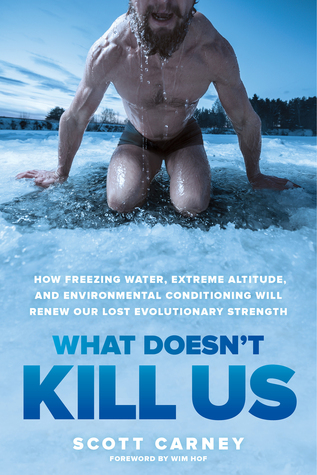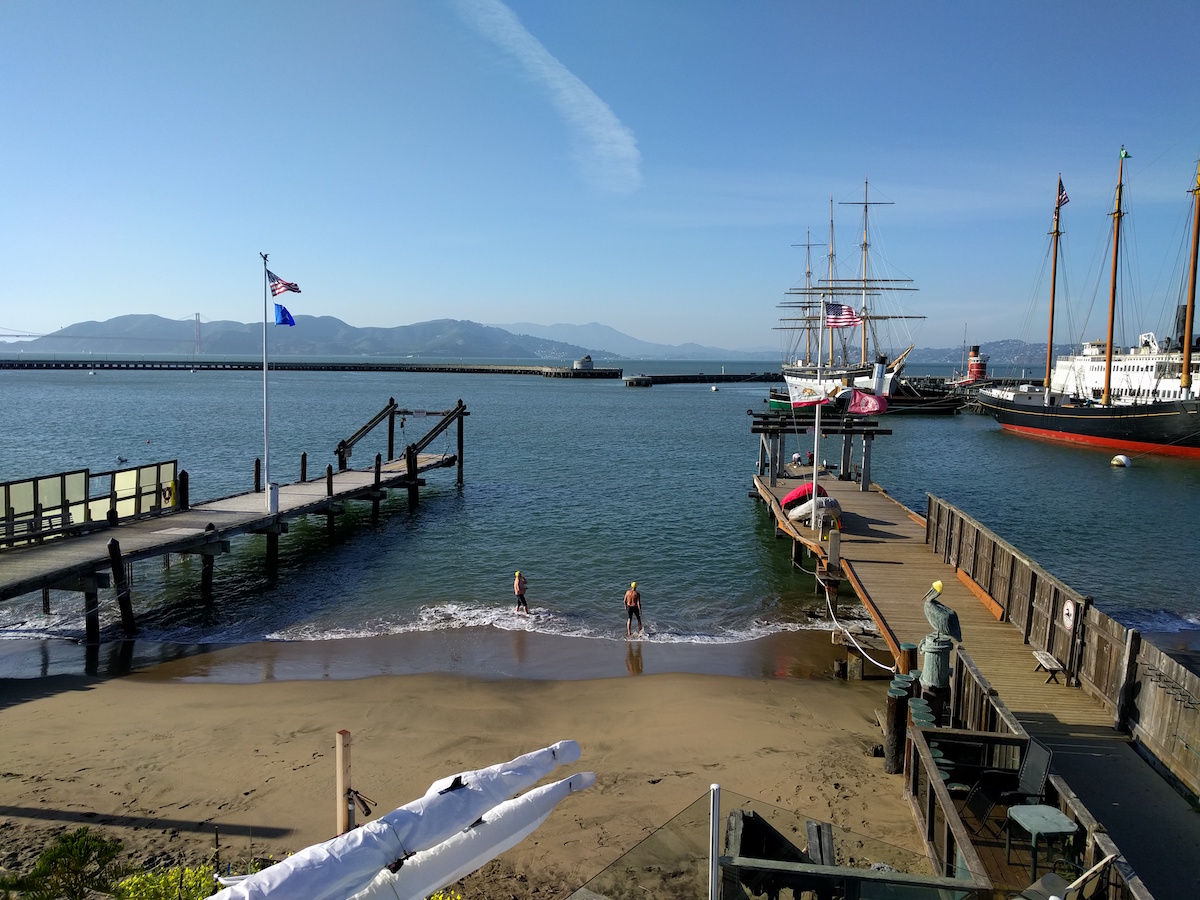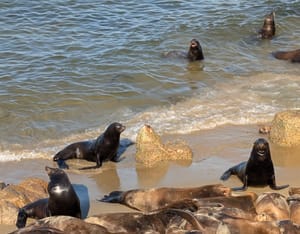I swam for an hour and 25 minutes on Saturday, with my swimming buddy Zina, and it was good. The sun was shining, the water was calm, there were no currents to speak of, and we explored a new-to-us route that took us from the far end of the breakwater guarding Fisherman’s wharf to the far end of the Fort Mason complex and back, for a total distance of about two miles.
It was less than I’d hoped for, though: I was going for 2:30 or 2:40. At least, that’s what my swim plan told me to do. But I got out after an hour and a half to get some warm water (mixed with carbohydrate powder) on the dock, where I’d left it in an insulated cup, and then I looked back at the water and … I just didn’t want to go back in.
There was nothing particularly wrong with me. I felt reasonably strong, my stroke was in good shape, I wasn’t too cold, and I’ve done a swim of 2:40 before, in water that was about the same temperature as it was Saturday (56 degrees F or about 13 C). Of course I wasn’t wearing a wetsuit, but that goes without saying in this series I’m writing.
The fact is, the human body has a remarkable ability to acclimate to cold water. People ask me about this, mentioning Coast Guard statistics saying you can’t possibly stay conscious longer than an hour or two in 50-60 degree water. But that’s for non-acclimated, non-swimming humans in emergency situations. English Channel swimmers spend ten, 12, sometimes 18+ hours in water at 14-18 C (57-64F), wearing nothing more than an ordinary swimsuit, a silicone swim cap, and goggles. But before they jump into the Channel, they need to train in cold water — in fact, you can’t even attempt the Channel without doing a qualifying swim of six hours in cold water (60 F or less).
While my swim July 9 will be much shorter (more like 3 hours, I expect), I need to go through a similar kind of training. And much of my training is about building up my body’s ability to handle the cold for that time.
It’s an odd ability, because you’d think that the second law of thermodynamics would reign supreme here: A small warm body surrounded by more or less infinite amounts of cold water is eventually going to lose heat to the water. In other words, it’s far more likely that your body will wind up being the temperature of the water than the reverse. In fact, that’s a given.
Or is it? The human body has a couple of defenses against the cold. One, it’s a mammalian body, which means it generates its own heat. This is particularly true if the body is in motion, because using your muscles generates heat, which means in addition to moving you forward, your muscles are also heating your blood.
Second, there’s a whole mechanism, the vasoconstrictive system, which can slow down the flow of blood to the skin and the extremities. This effectively sets up a heat exchanger on your circulatory system. Your forearms, hands, fingertips, lower legs, toes, the tip of your nose, and the surface of your skin become cold; your core remains warm; the blood flowing between the two regions passes slowly enough that the arterial blood (going out toward the surface) gets cooled down while the venous blood (coming back in to the core) gets warmed up.

As Scott Carney details in his fascinating and fun book What Doesn’t Kill Us, most of us have atrophied vasoconstrictive systems thanks to central heating and air conditioning. We like to hang out in comfortable temperatures, between 65 F and 75 F, so we design our homes and HVAC systems accordingly. But that’s not how humans, or really any mammals, evolved. Our bodies are made to adapt quickly and effectively to a wide range of environmental temperatures. Carney describes in some detail how methods invented by Dutch cold-water and breath-holding enthusiast Wim Hof (aka “The Iceman) can help augment those capabilities, and his book discusses his own experiments with doing extreme sports (a tough obstacle course, climbing Mt. Kilimanjaro) shirtless, wearing nothing but shorts and shoes, even in quite cold temperatures.

In fact, exposure to cold temperatures exercises the vasoconstrictive system, and there are some signs that this has real health benefits. Roger Deakin, in his book Waterlog, describes the results of a clinical experiment involving people who took a twelve-week course of daily cold baths, starting with five minutes at a time and working up to twenty. The study found, Deakin writes, that cold-water exposure reduced blood pressure and cholesterol levels, led to weight loss, decreased blood viscosity, increased anticoagulants and white blood cell counts, increased the oxygen capacity of the blood, increased the heart muscle thickness, lowered the pulse rate, increased production of plasmin (which can dissolve blood clots), and enhanced production of testosterone in men, and estrogen and progesterone in women, increasing fertility and libido.
The prolific blogger at LoneSwimmer has an enormous amount of experience in cold water and has studied and written about the topic far more than I have. He differentiates between habituation (getting used to the feeling of the cold, which is primarily psychological) and acclimation (the body’s ability to adapt to the cold physiologically). It’s a useful thing to keep in mind. The initial shock of the cold never quite goes away completely. Nor does the feeling of chilliness that you occasionally feel in your extremities. But if you get used to that shock, and hang in there for a few minutes, your body rapidly adjusts. And your ability to stay in cold water increases the longer you do it.
Now, if you want to try this yourself, don’t go alone. Learn the signs of mild and moderate hypothermia, because while mild hypothermia is a fact of life for cold water swimmers, moderate to severe hypothermia is a real risk, even for experienced swimmers. Without experience, you can become badly hypothermic far faster than you expect, and one of the particularly nasty effects of hypothermia is that it impairs your ability to make good decisions.
But if you want to try this, get yourself a buddy, and find a body of cold water to jump into. Get yourself ready by wading in up to your knees. Reach down into the water, get your wrists wet, and swirl your hands around in it — “like you were reaching into a cooler for a cold beer,” as someone once advised my friend Kate. Splash some water on your face, especially on your upper lip, below your nose (this helps cue your vagus nerve that cold water is coming, and that can help reduce the shock experience when you do plunge in.)
When you’re ready, plunge in with your whole body, immersing your head, and start swimming immediately. Breaststroke, crawl, doggy paddle, it doesn’t matter. You’ll find that initially, the water is painfully, shockingly cold—beyond cold even, into a different realm more accurately labeled “pain” or “WTF.” It will take your breath away at first, send your heart racing, and put you into a bit of a panic. The best thing to do here is to keep stroking and breathing rhythmically. Within a few seconds to a couple minutes your heart should start to slow down. Keep swimming and concentrate on breathing regularly. If you find yourself hyperventilating, stick your head out of the water for a minute and breathe more slowly.
Once you’ve caught your breath, you’ll notice that you’re no longer panicking—you’re just cold. Now is the time to start really swimming. Focus on doing your strokes well, the way you’ve practiced them, or however you’re comfortable swimming. But swim.
The first time you do this you probably won’t want to be in the water more than five or 10 minutes. That’s fine. Get out and warm up. Take off your wet swimsuit (as it will keep you cold far more than you think it will) and change into something warm. Keep in mind that your core temperature will continue to drop for 10 to 20 minutes after you get out, as your vasoconstrictive system relaxes and all that cold surface blood starts circulating back into the core of your body — this is known as the “after drop” and it’s a real, and often surprising, effect. Shivering is normal at this point, so don’t panic. Don’t jump right into a hot shower, at it can warm you up too fast and make you lightheaded or even make you pass out. A lukewarm shower, or a sauna, or sitting in your car with the heater on full blast, is far safer and more effective. Drink warm water, hot coffee, or tea. And bundle up. In half an hour or so, you should be feeling much more warm.
If you do this two or three times a week, you’ll find that you can gradually increase your time in the water. Within a few weeks you should be able to handle 20 or 30 minutes in fifty-ish water with no problem. You’ll be amazed at how quickly your body adapts.
And you might start noticing some of the benefits of the cold immersion: Fewer colds. Slower heart rate. Higher libido. And a general sense of wellbeing and freshness to the world. Also, your friends will start saying you must be crazy.
As for me, I’m going to continue with my training plan, with plenty of pool time and some shorter Bay swims planned for this week. A few things may have interfered with my ability to swim a long time last weekend: I didn’t have quite enough breakfast that morning. It was too easy to get out and stay out when my friend Zina got out. And I’d had a few beers the night before. Next Saturday, I’ll be aiming for two and a half hours or more, and this time, I’ll be better prepared.
I’m writing one or two posts a week about my journey towards a 6.5-mile swim in SF Bay on July 9. Would you like to follow along? Just give me your email address here: ↓ ↓
[xyz-ihs snippet=”swimform”]



